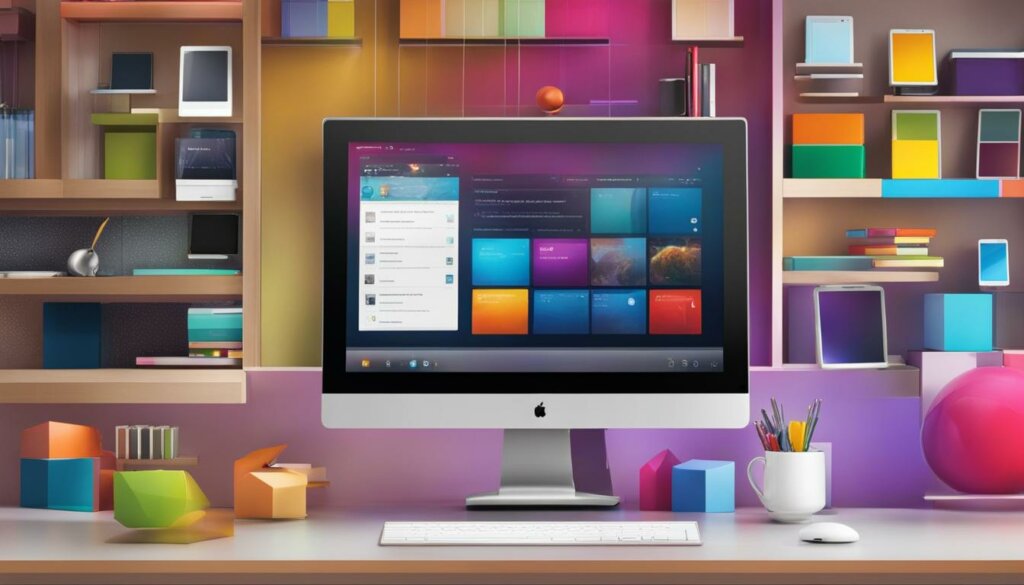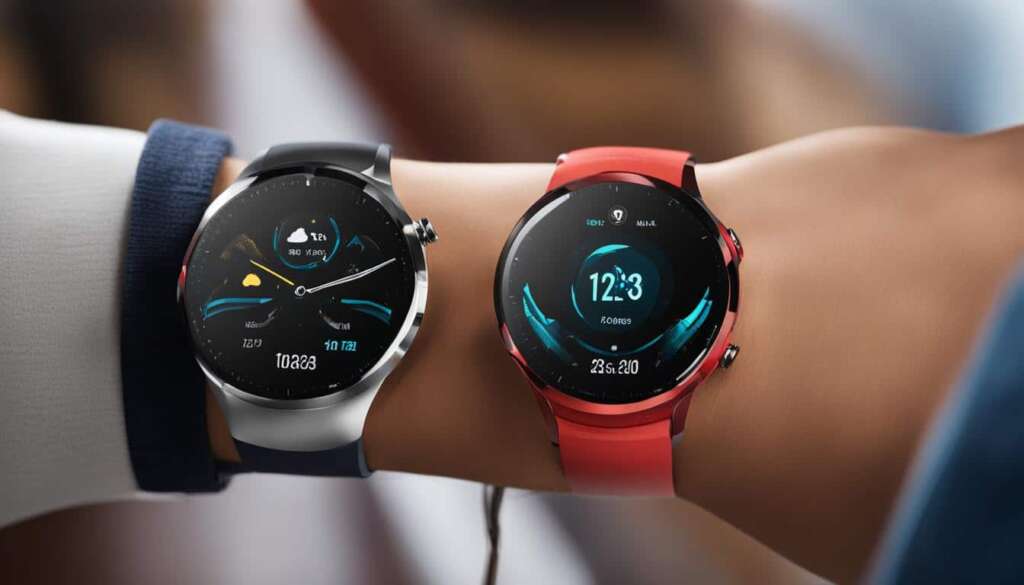Table of Contents
Touch Screen Technology has revolutionized our digital interactions, becoming an integral part of our daily lives. From touch screen devices to interactive touch screens, the advancements in touchscreen technology have been remarkable. In this article, we will explore the latest breakthroughs in touch screen technology, its applications, and the advantages it offers.
But first, let’s delve into the history of touch screen technology to understand how it has evolved over the years.
The History of Touchscreen Technology
Touchscreen technology has a rich history that dates back to the 1960s when E.A. Johnson developed the first touchscreen interface for traffic control in Malvern, England. This early touchscreen was a breakthrough in user interaction, paving the way for future advancements in the field. Over the years, touchscreen technology has continued to evolve, thanks to the contributions of pioneers like Dr. G. Samuel Hurst and Bob Boie.
However, it wasn’t until 2007 when Apple introduced the first touchscreen smartphone, the iPhone, that touchscreen technology truly revolutionized the industry. The iPhone’s multi-touch capability and intuitive interface set a new standard for mobile devices and sparked a wave of innovation in touchscreen technology.
Since then, touchscreens have become an integral part of our daily lives, with applications in various industries and sectors. From smartphones and tablets to interactive kiosks and self-service machines, touchscreens have transformed the way we interact with technology.
The Evolution of Touchscreen Technology
The evolution of touchscreen technology can be categorized into several key milestones:
- Capacitive Touchscreens: In the early days, touchscreens relied on resistive technology, which required pressure to register touch inputs. Capacitive touchscreens, introduced in the 1980s, revolutionized the industry by allowing users to interact with the screen through the natural conductivity of their fingertips.
- Multi-Touch Technology: The introduction of multi-touch technology in the 2000s enabled users to perform gestures such as zooming, rotating, and swiping, expanding the possibilities for touch-based interactions.
- Transparent OLED Screens: Transparent OLED screens, a recent development in touchscreen technology, offer a visually stunning and immersive experience. These screens allow users to interact with content while maintaining visibility through the screen.
As touchscreens continue to evolve, we can expect to see even more exciting advancements in the future. From touchless technology to predictive touch, the future of touchscreen technology holds endless possibilities for enhancing user experiences and transforming industries.
| Year | Milestone |
|---|---|
| 1960s | Development of the first touchscreen interface for traffic control by E.A. Johnson |
| 1980s | Introduction of capacitive touchscreens |
| 2007 | Launch of the first touchscreen smartphone, the iPhone |
| 2000s | Introduction of multi-touch technology |
| Present | Emergence of transparent OLED screens |
Advantages of Touchscreen Technology
Touchscreen technology offers numerous advantages over traditional input methods. Its user-friendly interface provides an intuitive and easy-to-navigate experience, making it accessible to people of all ages and abilities. With touchscreens, users can simply tap, swipe, or pinch to interact with the display, eliminating the need for complex keyboard shortcuts or mouse clicks. This simplicity of use enhances efficiency and reduces the learning curve for new users.
One of the key advantages of touchscreens is their ability to eliminate physical buttons, resulting in sleeker and more compact designs. Without the need for bulky keyboards or mice, touchscreens enable device manufacturers to create thinner and lighter products. This aspect is particularly beneficial for mobile devices like smartphones and tablets, where portability and aesthetics are highly valued.
Another significant advantage of touchscreens is their ease of cleaning and maintenance. Unlike traditional keyboards and mice, which can accumulate dirt and grime between the keys or buttons, touchscreens can be easily wiped clean with a soft cloth. This feature is especially important in industries that require strict hygiene standards, such as healthcare or food service.
Enhanced Accessibility and Time-Saving Features
In addition to the mentioned advantages, touchscreens offer enhanced accessibility features. They can accommodate various input methods, such as swiping, dragging, or using gestures, allowing users with different mobility levels to interact with the device effectively. This accessibility is particularly crucial for individuals with disabilities, enabling them to navigate digital interfaces more comfortably and independently.
Touchscreen technology also saves time in various industries. For example, in self-service kiosks, customers can quickly complete transactions or inquiries without the need to wait for assistance from a staff member. Similarly, in retail environments, touchscreens can facilitate faster product searches or provide additional information, resulting in a streamlined shopping experience for customers.
| Advantages of Touchscreen Technology | |
|---|---|
| User-friendly interface | Elimination of physical buttons |
| Easy to clean and maintain | Enhanced accessibility features |
| Sleeker and more compact designs | Time-saving features in various industries |

Touchscreen Applications in B2B and B2C
Touchscreen technology has not only revolutionized personal use (B2C) but has also found extensive applications in the business-to-business (B2B) sector. These applications span various industries, showcasing the versatility and adaptability of touch screen technology. One notable example of B2B touchscreen applications is the implementation of self-order systems in fast-food chains like McDonald’s. These systems have been successfully rolled out globally, resulting in increased revenue and improved customer satisfaction.
In the retail sector, touchscreens are increasingly being integrated into store displays as part of omnichannel strategies. By incorporating touchscreens in retail settings, businesses can enhance the customer experience, provide interactive product information, and facilitate self-service options. Touchscreens also find applications in industries such as healthcare, education, and hospitality, where they enable intuitive interfaces for medical devices, interactive learning experiences, and streamlined guest interactions.
One of the key advantages of touch screen technology in both B2B and B2C settings is its ability to enhance engagement and create immersive experiences. Touchscreens allow users to interact directly with the content, making it more memorable and impactful. Whether it’s navigating a menu, exploring products, or accessing information, touchscreens provide a user-friendly and intuitive interface that enhances the overall experience.
Table: Applications of Touchscreen Technology in B2B and B2C
| Industry | Applications |
|---|---|
| Retail | Interactive displays, self-service kiosks, product exploration |
| Healthcare | Medical device interfaces, patient education, telemedicine |
| Education | Interactive learning, digital whiteboards, collaborative classrooms |
| Hospitality | Interactive guest services, self-check-in kiosks, in-room entertainment |
| Manufacturing | Control panels, process monitoring, quality assurance |
| Transportation | Ticketing machines, self-check-in counters, wayfinding displays |
As touch screen technology continues to advance, the range of applications in both B2B and B2C settings is expected to expand further. With the potential for touchless technology, predictive touch features, and enhanced interactivity, the future of touchscreens holds exciting possibilities. Businesses across various industries are recognizing the value of touch screen technology and embracing its potential for improving customer experiences, increasing efficiency, and driving innovation.
Evolution of Touchscreen Technology
Since its origins, touchscreen technology has undergone significant evolution. It started with resistive touchscreens in the 1970s, which relied on pressure applied to the screen to register touch. In the 1980s, capacitive touchscreens emerged, using the conductive properties of the human body to detect touch. These capacitive touchscreens offered improved accuracy and responsiveness. However, the breakthrough came in the 2000s with the introduction of multi-touch technology, which allowed users to interact with the screen using multiple fingers simultaneously. This technology was popularized by the launch of the iPhone in 2007, revolutionizing the smartphone industry and paving the way for more innovative touch screen devices.
Today, touchscreens continue to evolve with advancements in transparent OLED screens, switchable glass, and large-format interactive touch frames. Transparent OLED screens are a cutting-edge technology that offers a unique visual experience. These self-lit screens provide stunning HD images that appear to float in mid-air, creating a futuristic and immersive display. Combine transparent OLED technology with interactive touch frames, and you have a versatile solution that allows users to interact with content while maintaining visibility through the screen.
Switchable glass, also known as smart glass, is another exciting development in touchscreen technology. With a simple touch of a button, switchable glass can change from frosted to clear, providing privacy on demand. When combined with interactive touch frames, this technology allows for interactive displays that can be turned opaque for private interaction or clear for public viewing. This versatility makes it particularly suitable for various environments such as educational institutions, workplaces, and retail settings.
Another area of advancement is large-format interactive touch frames. These frames have traditionally been used for retrofitting existing display screens, but recent advancements have allowed for the creation of custom touch frames in sizes up to 10m x 3m. These large-format touch frames, when combined with video walls or LED screens, create captivating interactive displays. The frames themselves are multi-touch, enabling multiple users to interact simultaneously, and can be installed slightly away from the screen for improved hygiene.

Evolution of Touchscreen Technology
| Decade | Technology |
|---|---|
| 1970s | Resistive touchscreens |
| 1980s | Capacitive touchscreens |
| 2000s | Multi-touch technology |
Interactive Transparent OLEDs
Transparent OLED screens are revolutionizing touch screen technology with their stunning visual impact and futuristic capabilities. These self-lit screens, combined with interactive touch frames, create a seamless and immersive user experience. The high-definition images displayed on transparent OLED screens appear to float in mid-air, captivating users and delivering content in a visually engaging manner.
One notable advantage of interactive transparent OLEDs is their ability to maintain visibility through the screen while still allowing users to interact with the content. This transparency ensures that users can seamlessly engage with the interface without any obstructions, enhancing the overall user experience. Whether it’s for informational displays, retail showcases, or interactive presentations, interactive transparent OLEDs offer a unique and cutting-edge solution.
“Interactive transparent OLEDs create a futuristic solution that allows users to interact with content while still maintaining visibility through the screen.”
Imagine a retail store where customers can interact with products showcased behind a transparent OLED screen. This interactive experience not only grabs attention but also provides an opportunity for customers to explore and learn more about the offerings. Additionally, interactive transparent OLEDs can be leveraged in museums, trade shows, and corporate settings, enabling interactive presentations and enhancing engagement.
| Advantages of Interactive Transparent OLEDs: | Applications: |
|---|---|
| Stunning visual impact | Informational displays |
| Seamless user experience | Retail showcases |
| Enhanced engagement | Interactive presentations |
As technology continues to advance, interactive transparent OLEDs open up new possibilities for touch screen technology. The combination of transparent displays and interactive touch frames provides an innovative and visually appealing solution that is well-suited for a range of applications in retail, entertainment, education, and more. With these advancements, the future of touch screen technology is bright and immersive.

Interactive Switchable Glass
Switchable glass, also known as smart glass, is a revolutionary technology that is transforming the way we interact with touch screens. With the touch of a button, switchable glass can change from frosted to clear, providing privacy on demand. This innovative solution is ideal for various environments such as educational institutions, workplaces, and retail settings.
Combining interactive touch frames with switchable glass creates a unique and versatile solution that enhances user experience and functionality. Users can seamlessly interact with the display when needed, and with the privacy feature, sensitive information can be protected easily. This technology allows for a seamless integration of touch screens in spaces where privacy and interactivity are both crucial.
Switchable glass technology offers numerous benefits. It eliminates the need for physical buttons or controls, creating a sleek and modern design. Its versatility allows for seamless integration into various settings, making it suitable for a wide range of applications. With its ability to transform from frosted to clear, switchable glass ensures privacy and maintains visibility when needed.
Benefits of Interactive Switchable Glass:
- Privacy on demand
- Enhanced user experience
- Sleek and modern design
- Versatility for various applications
- Seamless integration with interactive touch frames
In conclusion, interactive switchable glass technology is an exciting advancement in touch screen technology. Its ability to provide privacy on demand and combine interactivity with sleek design makes it a valuable solution for a wide range of industries and settings.
| Industry | Application |
|---|---|
| Retail | Interactive product displays |
| Education | Interactive learning environments |
| Workplace | Collaborative workspaces |
| Healthcare | Interactive medical interfaces |
Innovations in Touch Screen Technology
Touchscreen technology has come a long way since its inception in the 1960s. From the early days of capacitive touchscreens to the introduction of multi-touch devices in the 1980s, touch screen technology has evolved rapidly. Today, we are witnessing the latest innovations that are transforming our digital interactions. In this section, we will explore large format interactive touch frames, a cutting-edge development in touch screen technology.
Large format interactive touch frames have traditionally been used for retrofitting existing display screens. However, recent advancements have allowed for the creation of custom touch frames in sizes up to 10m x 3m. These large-format touch frames, when combined with video walls or LED screens, create a captivating interactive display experience. With their multi-touch capabilities, multiple users can interact simultaneously, making them suitable for various applications in both B2B and B2C settings.
To showcase the capabilities of large format interactive touch frames, let’s take a look at the following table presenting a comparison of interactive touch frame sizes:
| Screen Size | Applications | Benefits |
|---|---|---|
| 2m x 1.5m | Exhibitions, trade shows | Enhanced engagement, immersive experiences |
| 5m x 3m | Interactive digital signage | High visibility, impactful messaging |
| 10m x 3m | Conferences, events | Collaborative interactions, large-scale presentations |
As seen in the table, large format interactive touch frames offer a range of screen sizes for diverse applications. Their benefits include enhanced engagement, high visibility, and collaborative interactions. With the ability to create captivating interactive displays, large format interactive touch frames are driving the future of touch screen technology.
Interactive Touch Foils
Interactive touch foils are an innovative solution that adds interactivity to LCD and LED displays. These thin, transparent foils can be easily installed on existing glass surfaces, such as storefront windows or display cases. With interactive touch foils, users can seamlessly interact with the content displayed on the glass surface, making it a versatile solution for various industries.
One of the key advantages of interactive touch foils is their ability to provide interactivity without compromising security. The foils can be applied to the inside of the glass, protecting them from potential damage or vandalism. This makes them ideal for applications where users interact with the content from the outside, such as retail stores or exhibitions.
With recent advancements, interactive touch foils are now available in larger sizes, offering a more expansive canvas for interaction. These larger foils allow for more engaging experiences, whether it’s playing interactive games or browsing through product catalogs. The multi-touch capabilities of the foils enable multiple users to interact simultaneously, making them suitable for collaborative environments like educational institutions or corporate settings.
Applications of Interactive Touch Foils
Interactive touch foils have a wide range of applications across different industries. In retail settings, they can be used in window displays to attract customers and provide interactive product information. In museums, touch foils can enhance the visitor experience by allowing them to interact with exhibits and access additional information. These foils are also used in corporate environments for interactive presentations and collaborative workspaces.
Additionally, interactive touch foils are increasingly being integrated into smart homes and smart offices. By adding touch interactivity to glass surfaces like mirrors or tabletops, users can control various devices or access information conveniently. This not only enhances convenience but also adds a futuristic touch to the overall environment.
Conclusion
Interactive touch foils are a versatile and user-friendly solution that brings interactivity to existing glass surfaces. With their ease of installation, security features, and expanding size options, they are becoming increasingly popular in various industries. Whether it’s creating captivating retail displays, enhancing museum exhibits, or enabling interactive experiences in corporate settings, interactive touch foils offer endless possibilities for engaging and immersive digital interactions.
The Future of Touchscreen Technology
As touchscreen technology continues to evolve, we are on the cusp of exciting advancements that will revolutionize our digital interactions. One potential development is touchless technology, which aims to enable users to interact with displays without the need for physical contact. This technology has become increasingly relevant in the wake of the COVID-19 pandemic, as touchless interfaces can help maintain hygiene and reduce the spread of germs.
Another area of exploration is predictive touch technology. By utilizing sensor data and artificial intelligence, touchscreen devices can anticipate user intentions and provide a more seamless and intuitive experience. This advancement has significant implications for industries such as gaming and virtual reality, where precise and responsive touch inputs are crucial.
Furthermore, the future of touchscreen technology may involve the integration of haptic feedback. This technology would provide users with tactile sensations when interacting with touchscreens, enhancing the overall experience and bridging the gap between virtual and physical interactions. Haptic feedback could have applications in various fields, ranging from gaming and entertainment to healthcare and rehabilitation.
In summary, the future of touchscreen technology is bright and promising. From touchless interfaces to predictive touch and haptic feedback, these advancements have the potential to enhance user experiences, improve hygiene, and open up new possibilities for innovation. As technology continues to evolve, we can look forward to a world where our interactions with digital devices are more intuitive, immersive, and seamless than ever before.
Touch Screen Technology in Different Industries
Touchscreen technology has revolutionized various industries, enhancing digital interactions and transforming traditional processes. From marketing to healthcare, touch screen technology applications have become increasingly prevalent, offering a range of benefits and opportunities for innovation.
Marketing
In the field of marketing, touchscreens are being used to create interactive displays and kiosks that engage customers and enhance brand experiences. These touch-enabled platforms provide a more immersive and personalized way of presenting products and services, allowing customers to explore and interact with content in a hands-on manner. From retail stores to trade shows, touch screen technology has become a powerful tool for capturing attention and driving engagement.
Education
In the education sector, touch screen technology has revolutionized the way students learn and interact with information. Interactive touchscreens and whiteboards enable teachers to deliver dynamic and engaging lessons, promoting active participation and collaboration. Students can directly interact with digital content, solving problems, conducting research, and exploring educational materials in a more intuitive and interactive manner. Touchscreens have also made learning more accessible, catering to different learning styles and abilities.
Healthcare
In the healthcare industry, touch screen technology has transformed medical interfaces, improving efficiency and enhancing patient care. Touch-enabled devices, such as tablets and interactive kiosks, streamline administrative tasks, allowing healthcare professionals to access and update patient records on the go. Interactive touchscreens also enable intuitive navigation of medical imaging and diagnostic tools, enhancing accuracy and enabling more effective communication between healthcare providers and patients. Touch screen technology in healthcare settings has proven to be a valuable asset in reducing errors, enhancing productivity, and improving overall patient experiences.
Other Industries
In addition to marketing, education, and healthcare, touch screen technology has found applications in various other industries. In retail, touchscreens are used for self-service kiosks, enabling customers to browse products, place orders, and make payments conveniently. In hospitality, touch-enabled systems are used for check-ins, room controls, and interactive displays to enhance guest experiences. Touchscreens are also being utilized in industries such as banking, transportation, and entertainment, offering intuitive interfaces and unlocking new possibilities for user interactions.
| Industry | Touch Screen Technology Applications |
|---|---|
| Marketing | Interactive displays, kiosks |
| Education | Interactive whiteboards, digital learning tools |
| Healthcare | Medical interfaces, patient records, diagnostic tools |
| Retail | Self-service kiosks, product browsing, payments |
| Hospitality | Check-ins, room controls, interactive displays |
| Other | Banking, transportation, entertainment |
Conclusion
Touch screen technology has undoubtedly come a long way since its inception, and its continuous advancements are reshaping the future of digital interactions. From transparent OLED screens that offer stunning visuals to interactive touch foils that bring interactivity to existing displays, the possibilities are expanding.
The future of touchscreens holds even more exciting prospects. Touchless technology, allowing users to interact without physical contact, is on the horizon. Predictive touch technology, driven by sensor data and AI, aims to anticipate user intentions, further enhancing the user experience.
Touchscreens have become an integral part of various industries, revolutionizing marketing displays, electronic devices, education, healthcare, and more. As touch screen technology continues to evolve, it will undoubtedly open up new opportunities for innovation and provide enhanced user experiences.
With touch screen technology advancements shaping the future, we can expect an even more interactive, intuitive, and hygienic digital world. Touchscreens are here to stay, and their potential to transform industries and our daily lives is only growing.
FAQ
What is touchscreen technology?
Touchscreen technology is a type of input technology that allows users to interact with a display by touching it directly.
How has touchscreen technology evolved over the years?
Touchscreen technology has evolved from resistive touchscreens in the 1970s to capacitive touchscreens in the 1980s, and then to multi-touch technology in the 2000s.
What are the advantages of touchscreen technology?
Touchscreen technology offers a user-friendly interface, eliminates the need for physical buttons, and is easier to clean and maintain compared to traditional input methods.
Where is touchscreen technology used?
Touchscreen technology is used in various industries, including marketing, electronics, education, healthcare, and more.
What are the latest innovations in touchscreen technology?
The latest innovations include transparent OLED screens, switchable glass, large-format interactive touch frames, and interactive touch foils.
What is the future of touchscreen technology?
The future of touchscreen technology holds possibilities such as touchless technology and predictive touch, aiming to enhance user experience and expand the range of applications.
Source Links
- https://microtouch.com/the-evolution-of-touchscreen-technology/
- https://www.forbes.com/sites/forbestechcouncil/2022/07/20/a-brief-history-of-touchscreen-technology-from-the-iphone-to-multi-user-videowalls/?sh=2667aca1422e
- https://prodisplay.com/news/next-innovations-touchscreen-technology/







